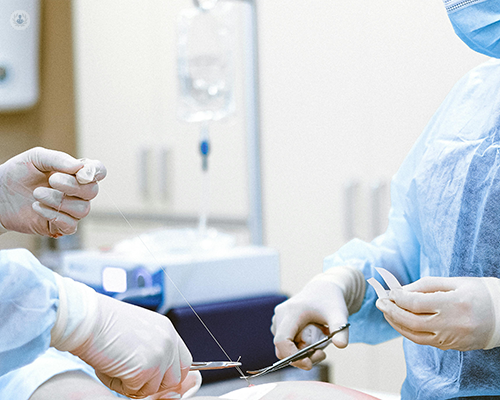Minimally invasive surgery (MIS): Enhancing patient care in gynaecology
Escrito por:Minimally invasive surgery (MIS) refers to surgical techniques that minimise the size of incisions needed and reduce trauma to the body during the procedure, allowing for faster recovery times and smaller scars.
Miss Nahid Gul, renowned consultant gynaecological, pelvic, robotic and laparoscopic surgeon, delves into the role of MIS in gynaecology, exploring its applications, benefits, and future directions in improving women's health outcomes.

What is MIS surgery?
Over the last 5-10 years, advancements in technology have allowed clinicians to perform complex operations with minimal access, using minimally invasive surgery (MIS). MIS involves making small incisions and performing the same operations that were previously conducted through large abdominal cuts. In gynaecology, the most common procedure still performed is a hysterectomy, so the question is, “How can we do that as minimally invasive as possible?” There are techniques such as laparoscopy and robotics which I use to do that and, as a result, my open rate for hysterectomies is less than 1%.
There are still many patients who undergo open operations or who have been denied an operation, especially if there is a benign cause, because they have been told their uterus is too big or they have a high BMI (body mass index). This is because when BMI exceeds 40, performing surgery can become challenging, and therefore it has been published that the conversion rates are high, meaning that patients end up undergoing open procedures because the surgery can’t be completed laparoscopically.
However, with proper assessment and training, all surgeries - even with very large uteruses or high BMIs - can be performed using laparoscopic or robotic techniques. So, size doesn’t matter; it's the proper assessment of the patient and the use of the appropriate technical tools that matter. The largest uterus I removed using MIS, for example, was nearly seven kilograms, which is quite large.
What techniques can be used to avoid an open operation and to enhance recovery?
Again, it comes down to the basics.
First, it’s about assessing the patient properly, listening to the patient properly, and diagnosing the patient properly. If patients have heavy periods and no other pathology, then we can use outpatient procedures such as Mirena coils or ablation to manage their condition. Patients don't even need a hysterectomy. However, if patients need a hysterectomy, that means they have another pathology, which can involve benign causes such as extensive endometriosis or malignancy causes such as cancer.
Second, it’s about asking, “How do we assess for this condition?” With MIS, yes, we can use port instruments to separate the uterus, but then how do we take it out from the body? This is where the preoperative assessment comes in.
If we have a patient who may have cancer or suspected cancer, then what we don’t want to do is morcellate the specimen. However, we can still perform MIS, in the sense that we can separate the uterus and then make a low transverse incision rather than a large midline incision to remove the specimen intact - almost like a caesarean section. By avoiding the big cut in the abdomen, we are automatically enhancing the patient’s recovery. As a result, the patient will still recover within four to six weeks compared to three to six months if they had a large midline laparotomy (a cut in the abdomen from the belly button down).
In benign cases, with proper assessment, we have instruments to morcellate the specimen safely in the bag and also avoid spilling. So, there are techniques we can employ to ensure these patients can recover as soon as possible.
What uterus size is too big for laparoscopic and robotic surgery?
I don’t think the size matters; it's the indication that matters. Obviously, if the operation is complex - for example, if the patient has a high BMI - we need to have a multidisciplinary team to support us because the patient may have anaesthetic problems or they may need HDU support.
However, if all possible treatment options have been considered and surgery is the last option, then size doesn’t matter as long as we have assessed the patient properly, the patient is counselled properly, and we have a proper setup.
What hysterectomy approach is best for patients with an enlarged uterus?
It’s minimal access, either laparoscopy or robotic, depending on the circumstances and the removal options for the specimen. Again, it all comes back to the preoperative assessment. The norm is that we will hopefully complete the operation laparoscopically or robotically, but very occasionally, the procedure may need to be converted to an open operation.
With large uteruses, I also think it's much easier to perform MIS compared to open surgery because there are fewer risks. Firstly, we can see much better than with our own naked eyes due to the technology in laparoscopy, 3D laparoscopy, or robotic assistants, which massively improve vision. Additionally, we don't need to use our hands to access the abdomen - even with robotic surgery, the devices resemble our hands - because we are working remotely through small incisions. So, we are getting all the advantages and minimising the risks.
The main complication with a larger uterus is bleeding and ureteric injuries because the blood supply to the uterus is quite significant and the ureters are also very, very close. However, if we first identify the ureters and identify the blood vessels, and then remove them, we can reduce the risk of complications and reduce the risk of bleeding. After this, we can separate the uterus and decide how we are going to remove it.
What is recovery like?
One of the advantages of MIS is that there is less postoperative pain. I’m especially very meticulous when I perform my operations and I don’t leave blood behind because when blood is left in the abdominal cavity, it works as an irritant, causing adhesions and pain. What I do is an avascular dissection, ensuring that blood loss during the operation is kept to a minimum. Therefore, when an abdomen is pristine, neat, and clean, then the postoperative pain is very little and there is less need for analgesics. This is an advantage because analgesics such as morphine cause constipation and bowel problems, meaning that the patient takes longer to recover.
One of the enhanced recovery principles which I use and which has shown to improve recovery is putting catheters, without any drains, to try and get patients to eat and drink soon after the operation. Most of my patients will therefore return home the next morning but should avoid heavy lifting for six to eight weeks, especially if they had a total hysterectomy where we suture the top of the vagina. If patients perform strenuous exercises, then there is a risk that the sutures won’t heal properly.
My patients will go back to driving within a week to 10 days, once they are comfortably able to sit in the driver’s seat, put on a seatbelt, and perform an emergency brake. They will also be able to work within three to four weeks, depending on their circumstances. Every patient is different and there is no set time when it comes to recovery, but with MIS the quality of life is significantly improved as compared to an open operation.
Only in certain cases, for example if a patient has a large ovarian malignancy, will they need an open operation. The hospital stay will then be two to three days, and the recovery will be a little more delayed compared to MIS.
To schedule an appointment with Miss Nahid Gul, head on over to her Top Doctors profile today.


